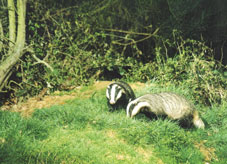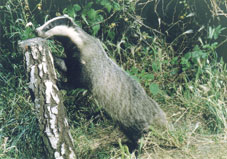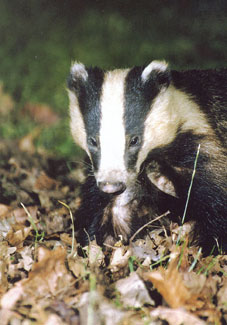The Badger - Healthy Life Essex
Home » Articles » Outdoor Life » Wildlife » Mammals » The Badger
The Badger
OUR MOST ANCIENT BRITON
The badger is a member of the weasel family, the mustelidae, a group of mammals which includes the otter, polecat, pine marten, stoat and weasel. It is the largest member of the family in Britain. A large male (boar) may weigh 12 kilograms and measure 75cm along the body with a tail of 15cm. They are grey with a distinctive black and white striped head.

Badgers live underground in a system of tunnels and chambers system known as a sett. The sett can vary in size from one or two entrance holes to about fifty, the average being between three and ten. These are a distinctive semi-circular shape, flat at the bottom, about 30cm wide and 25cm high. Badgers are persistent diggers, and a large amount of spoil can accumulate outside each entrance hole that is in use.
They like to line their sleeping chambers with fresh bedding that consists of grass and other herbage. The badger will roll this into a ball with its front paws and, hugging the bundle to its chest ,will walk backwards into the sett. This operation will occur several times. Bedding bundles can often be found, left to air, just outside the entrance holes. You should be able to find a trail of bedding along a pathway where a badger has travelled.
The badger keeps its sett very clean. They deposit their dung in shallow pits clustered together, usually away from the entrances to the sett. Unlike the fox they do not bring food back to the sett.

Badgers are family animals and do not mix with badgers outside their own clan – thus they are very territorial creatures. They will have more then one sett in their area, though the smaller setts are only used temporarily. The badger is a fairly heavy animal and low to the ground. They make well worn paths which may be used over many generations.

Badgers are omnivorous creatures, eating a wide variety of foods. Their favourite food is the common earthworm but their diet also includes insects, fruit, cereals and carrion. Badgers are foragers rather than hunters, locating their food by scent as their eyesight is very poor. With their nose to the ground they will quite noisily push through undergrowth in search of food. Young rabbits are also a favoured food item. The badger locates the nest from above ground with its keen sense of smell, then digs down for its evening meal!
Badgers have only one enemy – man
Even today badgers are still persecuted, despite the legislation to protect them
The illegal sport of badger digging continues to occur around England. It involves men sending dogs down into the sett to find the badger, which is then dug out and put with a number of dogs to fight until death. Sometimes badgers suffer terrible injuries before they are thrown to the dogs. Badgers are also frequently killed on the roads. For some people this is the only time that they see a real badger. New housing development and roads are a major threat to badgers and often the land they forage on is lost to concrete as their setts come under the destructive bucket of a JCB.
Watching at a badger sett can be a very rewarding pastime in the evenings. Once you have located the

sett, ask the landowner or park rangers permission to watch, and let him know when you will be watching. Badgers tend to emerge from their sett at dusk, so arrive early and silently. Wear dark clothing that will not rustle in the breeze or when you move.
Remember the badger has a keen sense of smell, so try not to walk on the badger’s pathways or over the sett as this will leave your scent. Some peanuts can be placed close to the sett entrance to keep the badgers in sight for a while before they go off to forage. Choose somewhere to stand that is not too

close to the sett but is in view of an entrance hole that has been well used. The hole should be clear of debris and have a well worn pathway leading from it, with possibly a fresh spoil heap at the front. If there is a slight breeze this should be blowing into your face, so as to blow the scent of you away from the badgers. Make sure that you stand by a tree or bush, as standing out in the open will cast dark shadows that are not usually there. Now all you have to do is stand silently and patiently – and if you are lucky, you will soon be rewarded with the sight of badgers in their natural habitat.
Frank Last.
Chairman, Essex Badger Protection Group
Photographs courtesy of Barry Crowley
There are many organisations operating throughout England that have the welfare of badgers and other wildlife at heart. The Essex Badger Protection Group covers ninety per cent of Essex and the group has been operating for over fifteen years on a voluntary basis. We are always looking for new members who wish to take an active role, in various ways from fundraising to monitoring setts. If you would like to know more please contact:
Frank Last
Chairman
Essex Badger Protection Group
Milton Lodge,
Milton Road,
Corringham, Essex.
SS17 8JP
Or see the website: www.essexbadger.co.uk
How you can help protect Badgers
People digging for badgers will normally have two or three terriers or lurcher dogs with them and will also be equipped with spades and sacks.
If you see such persons and genuinely believe they are digging for badgers do not directly challenge them. Make a note of their description, their dogs and the tools they have in their possession, together with the registration numbers of vehicles you believe to be associated with them. Call the police at once, giving the location of the incident
Other Badger protection Groups in Essex:
- The Essex Badger Protection Group
- The North East Essex badger group
- The Uttlesford Badger Group
- The Epping Forest Badger Group
See also the Healthy Life Essex article: The Badger – Coco’s Tale
